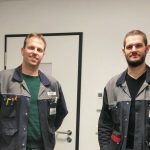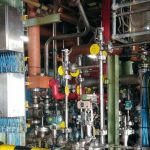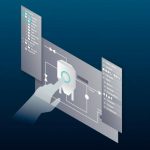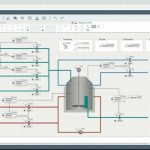Mr. Sonnborn, at Levaco a new distributed process control system is in use. What is it used for and in what environment?
Thomas Sonnborn: The implementation took place in the course of a major rebuild of a reactor. One can imagine such a reactor as a large cauldron in which chemical intermediates are produced. In concrete terms, this mainly involves defoamers and surfactants, i.e. components that make products water-soluble. For this reactor, Simatic PCS neo is now used as the superordinate control systemthat controls the process. We want to be well-prepared for the future. It replaced an outdated system that had mainly worked with binary signals, and many operating steps still had to be carried out manually. For example, valves were previously switched by hand.
You specifically chose this distributed process control system – why?
Sonnborn: The main factor for the decision was the system’s focus on digitalisation. We wanted to keep up with the latest technology and have a foot in the new world. We are talking about a web-based control system – with all its advantages: for example, one has access to all information from serval locations and you can call up the visualisation regardless of location. This transparency is a real progress.
Please explain why you chose Siemens.
Sonnborn: This was a pragmatic decision insofar as we already had experience with the good on-site support from Siemens through the Simatic PCS 7 distributed process control system. Since 70 % of our plant is already running with Simatic PCS 7, our programmers and electricians are already trained in Siemens hardware and software.
Stephan Wolf: Additionally, the IO level with its hardware components is the same as with Simatic PCS 7. Therefore, an efficient transition towards Simatic PCS neo in the whole plant is possible at any time.
Sonnborn: Exactly – this enables us to be flexible and keeps all opportunities open for the future.
By now, you have already gained experiences with the new distributed control system – which advantages have you seen so far in your operations at Levaco?
Sonnborn: Here I want to pinpoint the visualisation: There are more setting options and very precise, good visualisations, such as curve diagrams. Especially fast zooming and the large variety of specific symbols, for example for temperature probes, make operation easier. A very important aspect compared to the outdated automation system previously installed in the plant is that with Simatic PCS neo, we have regained the power over the plant – through transparency. This is because the control system allows us to take a look inside the plant, which was previously a black box. Now, we can intervene and change processes or optimise them. Thanks to numerous basic functions, we have many more options – whether it involves the temperature or the dosage. What used to have to be set by hand is now done automatically, such as opening valves to reach a defined temperature. Now, you simply enter a set point – and the plant regulates it.
That sounds like huge changes with high potential.
Sonnborn: Absolutely.
How do these improvements affect the performance of the plant?
Sonnborn: The possibilities for quick fine-tuning have a positive impact on the quality. This has improved of course. In addition, the processes are much safer. The new safety considerations have led to optimised processes, for example by replacing manual equipment with automatic equipment. Many things havo also become faster, not least thanks to the new computers. Overall, the performance has definitely improved.
What would you describe as the most important feature of the new system?
Sonnborn: In short: with Simatic PCS neo, all information is available on every computer and one has insight into the whole plant. This extends to remote maintenance. Since we have implemented remote maintenance access to our plant, we have been able to access the required information very conveniently and securely, regardless of location. This is also a big step and offers many advantages.
Let’s take one step back in the chronology and look at the implementation of the new system. Can you briefly describe this phase?
Sonnborn: When looking back, it was a complex conversion with high requirements – sometimes a rocky road for both sides – for Siemens and for us. We also had to do our homework and rethink and describe all the processes and basic functions in detail. But it was worth it. In the end, we have got a significantly better result. And it was an investment in the future. Further development can build on this basis. But let‘s be specific about the implementation: First, the system was set up at Siemens and the individual step chains and basic functions were tested live. After successful testing, the system was set up at Levaco. After everything was wired on site, the next step was to test the basic functions via IO test. Following this phase, we demolished the old plant in just a few weeks and built the new one – and operation started immediately. We were able to successfully implement our optimistic timing.
Can you specify the part regarding the collaboration?
Sonnborn: Yes, of course,the collaboration worked very well. We were always in close contact with the programmers and the project coordinator and discussed the current status: whether it was the wiring or the status of soft- and hardware. And we always received direct feedback on our wishes and ideas, for example with regard to the design of the basic functions. There were many conversations – no matter what they were about – we always had a contact person at Siemens. That worked out really well.
Following the implementation there was a start phase: how did you experience the incorporation in Simatic PCS neo?
Sonnborn: As Simatic PCS 7 experts, it was quite easy, and a routine was established very quickly. But especially for programming we plan to take a course.
Do you already have first experiences in readjustments and changes in daily use? How well can these be realised in the new distributed process control system?
Wolf: We are very familiar with the system, so we can implement changes without any problems.
With 3.0 as one of the first released versions, you are one of the so-called “early adopters”. Which of the upcoming features is the one you are most looking forward to?
Sonnborn: I‘m thinking of two features: integration of a failsafe control and realisation of batch processes. As far as we know, both are on their way and will be released in the upcoming versions.
Let us take a look into the future – which long-term perspective do you see for this plant?
Sonnborn: With this plant, we are well-equipped for the upcoming decades if we update it accordingly.
If you draw a short conclusion: for whom would you recommend the web-based control system?
Sonnborn: Those who want a good visualisation and who have many clients clearly benefit from Simatic PCS neo: without the need to configure individual clients, the web-based system can be launched quickly and cost-effectively.
Mr. Sonnborn, Mr. Wolf, thank you for the interview.
Siemens AG, Nürnberg, Germany
Hall 11.0, Booth E14
The interview was conducted by:Daniela Held
Editor
“We want to have a foot in the digitalised world with the web-based control system.“











